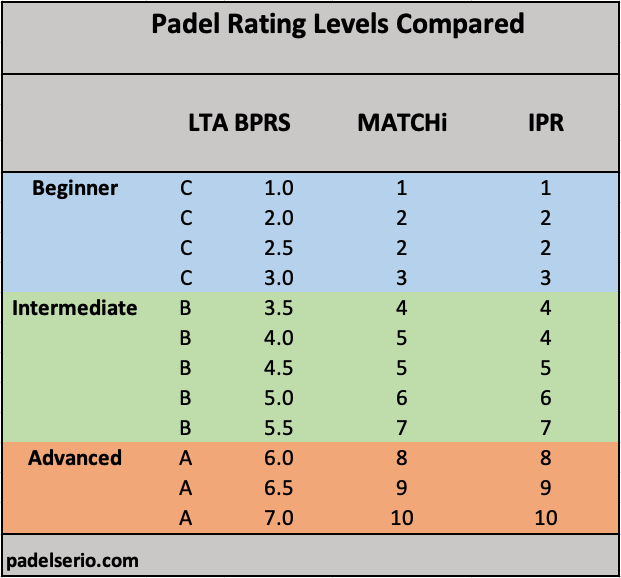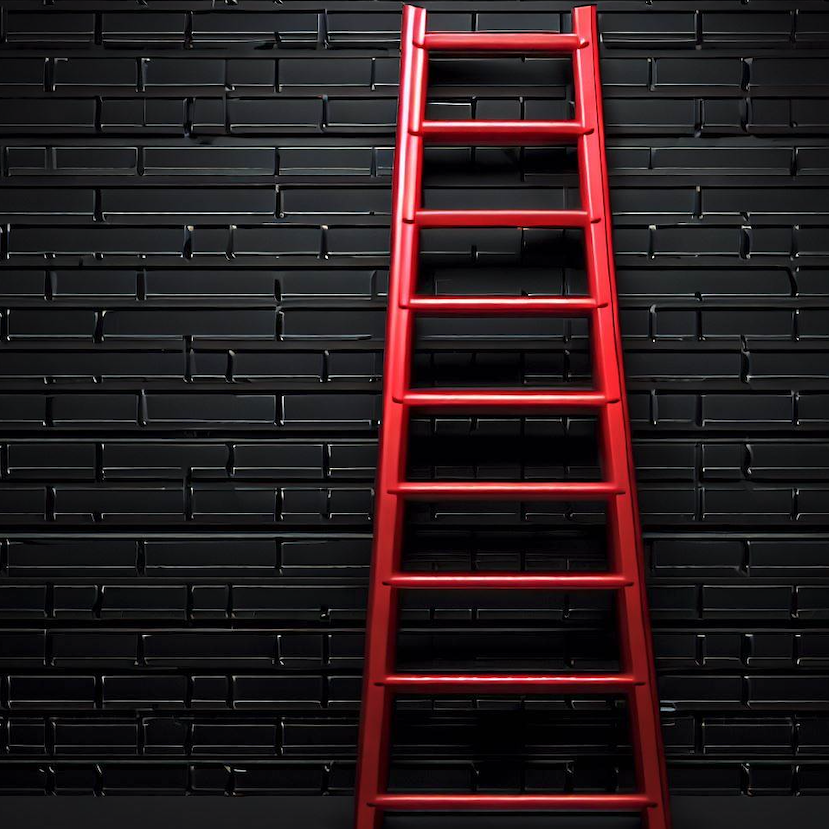Introduction
If you have started playing padel you might be starting to wonder what your padel level is and how it is determined.
Padel levels are a way of measuring the skill and experience of padel players.
In this post we will explain what padel levels are, how they are assessed, why they are important, and how they can help you improve your game.
Padel Levels: What are they and how are they determined?
There are numerous different but similar scales and systems for determining padel levels, depending on the country or region where you live and play.
We will explore three of the most commonly used systems but keep in mind that there are other formats out there.
In general all the systems group player levels into beginner, intermediate and advanced and then describe skills that define a player’s position within these groups.

The LTA British Padel Rating System (BPRS)
This system is used in the UK, Spain and other European countries.
It uses a numeric scale from 1 to 7, where 1 is a beginner and 7 is a professional.
There are 12 grades within this scale as half points are used.
Letters A, B, C, are also used to group ability more broadly into categories within these 12 grades.
The BPRS evaluates players based on their strokes, serve, use of walls, volleys, overheads, position, and tactics.
The BPRS for padel was developed by the British Padel Association (BPA) in collaboration with the International Padel Federation (FIP) and other national padel federations.
The BPRS aims to provide a consistent and objective way of rating padel players across different countries and regions.
The LTA BPRS levels
Level 1.0: Complete Beginner (C)
Just started playing padel. Difficulty keeping the ball rolling, no padel skills.
Level 2.0: Beginner (C)
Knows basics, but inconsistent and uncontrolled. Likes to avoid backhand shots, has difficulty with positioning, but can keep the ball moving. Focus on making the serve and reducing double faults. Attempting volleys at the net, but with poor results. Tries using walls but regularly fails.
Level 2.5: Beginner (C)
Speed of ball has increased and returns are more consistent. Spending more time at the net, hitting volleys with some success. Managing a few successful rebounds off the walls.
Level 3.0: Recreational (C)
More confident with basic strokes like forehand, backhand, and lob. Few double faults and dares to try and follow up at the net. Rarely uses the back wall. Confident in hitting the ball, but the focus is on getting the ball in.
Player has a single variant of overhead shot. Starting to understand the basic tactics but still having trouble with positioning. Often ends up where they shouldn’t be.
Level 3.5: Recreational (B)
Has better control of the ball and shot accuracy. Consistency is improving. Speed of ball is increasing and has good communication and positioning on court in relation to partner.
Level 4.0: Average (B)
Played for a while and knows the basics well. Can increase the pace of the game but does not always play consistently. Serving / releasing can still be inconsistent. Can use both walls before or after hitting. Volley and smash with some power. Better positioning on court. Good assessment of opposition for targeted shots.
Level 4.5: Average (B)
A more assertive padel player. Creates opportunities for winning shots. Still makes a few mistakes on easy and difficult shots but is normally in the correct court position.
Level 5.0: Average Advanced (B)
Has been playing for a couple of years and gets most balls over net with reasonable power. Serving/releasing more consistent. Uses both walls before or after hitting. Can volley and smash with more power. Utilises forehand lob effectively. Positions themselves and their partner better on court. Using strategy and is aware when to take chances to execute winners.
Level 5.5: Average Advanced (A)
A more consistent, current and physically fit version of previous level. Makes fewer errors due to playing more regularly. Has a slightly more refined mental game.
Level 6.0: Experienced (A)
Like 5.0 and 5.5 but with better smash and special shots. Serving/releasing highly consistent. Positioning, shot making, execution, coordination and communication with partner all at semi-professional level. Plenty of variation and strategy. Has a world ranking outside world top 250.
Level 6.5: Experienced (A)
Professional competition player ranked inside the world top 250. Fitness and experience at competition level differentiates this player from 6.0.
Level 7.0: Skilled (A)
Excellent consistency and control. Complex shots with precision and power. Uses walls creatively. Dominates game with speed and accuracy. Sophisticated variation and strategy. A professional player inside the world top 100.

The International Padel Rating System (IPR)
This system is used by the International Padel Federation (FIP) and some other countries.
It uses a numeric scale from 1 to 10, where 1 is a beginner and 10 is a professional.
The IPR evaluates players based on their technical, tactical, physical, and mental aspects.
The IPR was created by the FIP in 2016 as a global standard for padel levels.
The IPR is based on the results of official padel tournaments organised by the FIP or its affiliated national federations.
The IPR allows players to compare their level with other players around the world and to participate in international events.
The IPR levels
Level 1: Beginner
Difficulty keeping the ball rolling. Does not know the rules or the basic strokes.
Level 2: Beginner Advanced
Knows the rules and the basic strokes, but lacks consistency and control. Does not use the walls or the net effectively.
Level 3: Recreational Player
Has some consistency and control, but still makes many errors. Uses the walls occasionally, but not the net. Has a limited repertoire of strokes and tactics.
Level 4: Average Player
Has more consistency and control, but still struggles with difficult balls. Uses the walls and the net more frequently, but not optimally. Has a wider repertoire of strokes and tactics, but not very effective.
Level 5: Average Advanced Player
Has good consistency and control, but still makes some errors under pressure. Uses the walls and the net well, but not strategically. Has a varied repertoire of strokes and tactics, but not very refined.
Level 6: Experienced Player
Has high consistency and control, and can handle difficult balls well. Uses the walls and the net strategically, and can create opportunities for attack or defence. Has a rich repertoire of strokes and tactics, and can adapt to different situations and opponents.
Level 7: Skilled Player
Has excellent consistency and control, and can execute complex shots with precision and power. Uses the walls and the net creatively, and can dominate the game with speed and accuracy. Has a sophisticated repertoire of strokes and tactics, and can anticipate and counteract the opponent’s moves.
Level 8: Expert Player
Has outstanding consistency and control, and can perform any shot with ease and effectiveness. Uses the walls and the net masterfully, and can impose their style and rhythm on the game. Has a comprehensive repertoire of strokes and tactics, and can exploit the opponent’s weaknesses and strengths.
Level 9: Professional Player
Has exceptional consistency and control, and can execute any shot with perfection and flair. Uses the walls and the net superbly, and can control every aspect of the game. Has an extensive repertoire of strokes and tactics, and can adapt to any scenario and challenge. Plays regional and national tournaments
Level 10: World Class Player
Has extraordinary consistency and control, and can execute any shot with brilliance and innovation. Uses the walls and the net magnificently, and can dazzle with their skill and technique. Has an exhaustive repertoire of strokes and tactics, and can dominate any opponent and situation. Plays world padel tournaments.

The MATCHi scale
The MATCHi scale was developed by MATCHi AB, a company that provides online booking services for padel courts.
It is based on the self-assessment of players who use the MATCHi platform to book their games.
The MATCHi scale helps players to find compatible opponents and partners within the MATCHi community.
This system is used in Sweden and some other Nordic countries.
It uses a numeric scale from 1 to 10, where 1 is a beginner and 10 is a World Pro.
The MATCHi scale evaluates players based on their consistency, control, speed, power, variation, and strategy.
The MATCHi levels
Level 1: Never Held A Racket Before
Difficulty keeping the ball rolling. Slightly bewildered.
Level 2: Beginner
Still learning the basics of padel. Focus on making the serve and reducing double faults. Daring to try to get to the net, but with poor results.
Level 3: Beginner Advanced
More confident with basic forehand strokes and backhand strokes, experimenting with forehand lobs. Fewer double faults and dares to try to get to the net. Rarely use the back wall. Confident to hit the ball, but the focus is on getting the ball in. Has a single variant of overhead shot and the focus is on putting the ball in the court. Starting to understand the logic but still having trouble positioning. Often ends up out of position on court.
Level 4: Recreational Player
Played for a while and knows the basics well. Can increase the pace of the game and has good control, but does not play consistently. Serving/releasing can still be inconsistent. Uses both walls before hitting or after hitting. Volley shots have some power. Can smash with some power. Positioning is better on court. Varies their shots and uses some strategy in their game.
Level 5: Average
Has been playing for a couple of years and gets most balls over net with reasonable power. Has a more aggressive serve. Uses both walls before hitting or after hitting. Can volley with more power. Can handle difficult balls and pressure situations.
Level 6: Average Advanced
Like level 5 but with better smash and flat shots. Serving/releasing more consistent. Executes deep volleys and backhand volleys with more power. Can smash with more power. Positions themselves and their partner better on court. Can vary their shots and use more strategy in their game. Easily manages difficult balls and pressure situations.
Level 7: Experienced
Can defend and effectively turn the game against opponents. Can put pressure on the opponent with powerful volleys, build up the game and hit winning shots. Probably combines matches with specific padel exercises.
Level 8: Skilled
Has full control of the technical and tactical aspects of padel. Reads the game well and uses different tactics depending on the opposition. In their club they belong to the top level of players and practice padel regularly, mostly with coaches.
Level 9: Expert
Belongs amongst the absolute best players and plays padel at the highest levels with good results.
Level 10: World Top 10 player
No words needed!
Summary Comparison Table
Below we have summarised these three rating systems together in one table.
Whichever system you are using this will help quickly give an idea of the equivalent levels in other rating systems and the category.

Padel Levels: Why are they important and how can they help you improve your game?
Knowing your padel level can help you improve your game by finding the right challenges and opportunities for learning.
They can help you find suitable opponents, partners, and coaches for your game.
They can also help you track your progress and set your goals when practicing and playing padel.
Playing with people of similar or slightly higher level can help you develop your skills and enjoy the game more.
Playing with people of much lower or higher level can be frustrating or boring for both parties.
However, padel levels are not fixed or permanent. They can change over time as you play matches depending on your practice, training, motivation, and other factors.
Therefore it is important to keep checking and updating your padel level regularly so that you can adjust accordingly your practice, game, focus and opponents!
Conclusion
In this post we have explained what padel levels are, how a few commonly used scales are determined and why knowing your padel level is important.
We hope that this post has been helpful and informative and wish you every success in progressing enjoyably through the levels on your padel journey!
What to read next
Completely new to padel? Read our beginner’s guide.
Want to know how to win more points as a beginner?
How popular is padel worldwide?
